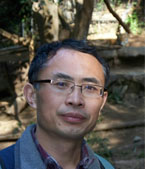
The 3rd International Conference on New Energy and Future Energy System
August 21st - 24th, 2018, Shanghai, China

 |
Prof. Shijie Liu Professor and Associate Chair Department of Paper and Bioprocess Engineering State University of New York New York, USA |
Keynote speech title: ENZYMATIC HYDROLYSIS OF PAULOWNIA PULP Abstract: As one of the most abundant polymers on earth, lignocellulosics or cellulose from woody biomass is an important industrial raw material and source of renewable energy. The enzymatic hydrolysis of cellulose pulp to glucose by cellulase is one of the major methods to convert lignocellulosic biomass to biofuel and biomaterials. Enzymatic hydrolysis, catalyzed by cellulase, is a heterogeneous reaction, which is influenced by characteristics of cellulose (e.g. crystallinity, the degree of polymerization and accessible surface area) and other biomass components (lignin and hemicellulose). In this study paulownia pulp, after hot-water pretreatment and delignification was utilized as the substrate while a preparatory commercial cellulase composed of endoglucanase, exo-glucanase, and β-glucosidase was employed as the catalyst. The effect of temperature and pH were investigated. In the temperature experiment, the highest yield of sugar was reached at 55°C in 72 hours. For the pH, the highest conversion was achieved at 4.8 in 96 hours. Kinetic studies were performed with different enzyme loadings. Proton NMR was used for the quantification of glucose and cellobiose. The highest glucose yield in 166 hours was found to be 62.5% at 18.5FPU/g while cellobiose remained at a low and relatively constant concentration during the process. A kinetic model was developed based on a proposed mechanism to explain the production of glucose. The hydrolysis rate was found to increase with increasing temperature at short reaction times, while decrease with increasing temperature at long reaction times. |
|
 |
Prof. Fang Chao Professor Institute of Nuclear and New Energy Technology Tsinghua University, China |
Keynote speech title: Process Heat Application of HTGR: Adaptability and Potential in Energy Market Abstract: High Temperature Gas Cooled Reactor (HTGR) is considered as a kind of GEN IV nuclear reactor and because of its meltdown-immune feature, the practical elimination of large radioactive release from nuclear power plants becomes reliable with this technology. The first demonstration project of modular HTGR in the world (HTR-PM), is under construction in Shidao Bay (in Shandong Province, China) and is planned to operate at the middle of 2019. Besides supplying electricity traditionally, HTGR could also supply high-quality process heat (7.0MPa & 750℃ helium or 14.0MPa & 570℃ steam) to industrial facilities. Here, we will analyze the adaptability of process heat supplied by HTGR in different fields, including oil refinery industry, coal chemical industry, hydrogen manufacturing industry, etc. firstly. Secondly, the benefit of using HTGR process heat, such as reducing the GHG emission and environment-friendly will be discussed and furthermore, some technical challenges will also be shown. Based on the above mentioned analysis, it is found that process heat application potential market of HTGR is wide because it may supply high quality heat with a wide temperature range. However, the development of this application strongly depends on policy factors including carbon tax and public acceptance. |
|
 photo: Damian Gorczany |
Prof. Dr.-Ing. Hermann-Josef Wagner Ruhr-University Bochum, Germany |
Keynote speech title: Life cycle assessment of the offshore wind farm alpha ventus Abstract: Due to better wind conditions at sea, offshore wind farms have the advantages of higher electricity production compared to onshore and inland wind farms. In contrast, a greater material input, leading to increased energy consumptions and emissions during the production phase, is required to build offshore wind farms. These contrary effects are investigated for the first German offshore wind farm alpha ventus in the North Sea. In a life cycle assessment, its environmental influence is compared to that of Germany’s electricity mix. In comparison to the existent electricity mix, in Germany alpha ventus had better indicators in nearly every investigated impact category. One kilowatt-hour electricity, generated by the wind farm, was burdened with 0,137 kWh Primary Energy-Equivalent and 32 g CO2-Equivalent, which represented only a small proportion of the accordant values for the mix. Furthermore, the offshore foundations as well as the submarine cable were the main energy intensive components. The energetic and greenhouse gas payback period was less than one year. Therefore, offshore wind power, even in deep water, is compatible with the switch to sustainable electricity production relying on renewable energies. It was the first published eco-balance for an offshore wind park worldwide. |
|